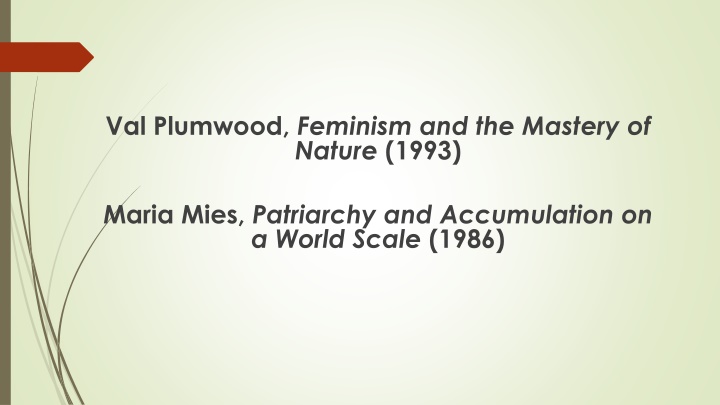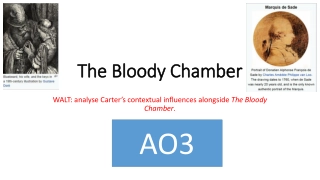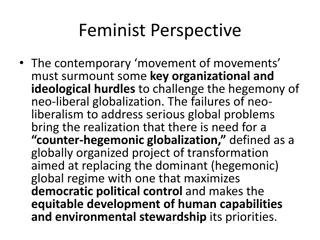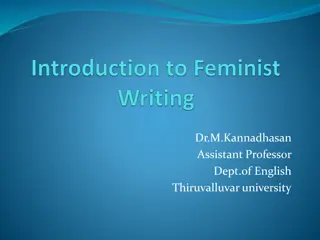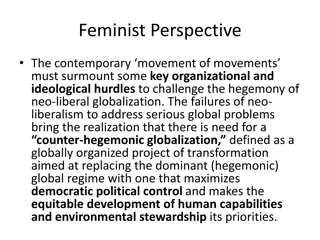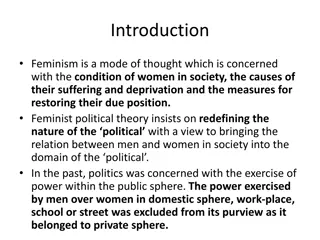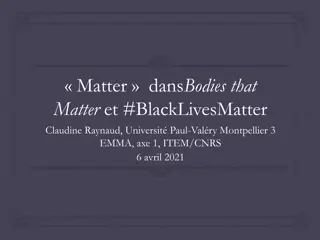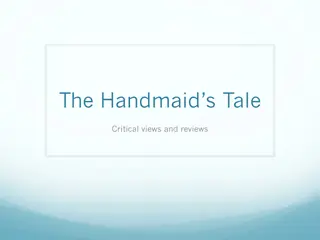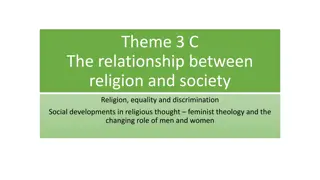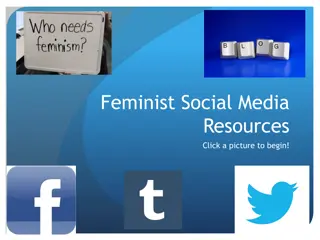Intersection of Ecofeminism and Feminist Theory
The intersection of ecofeminism and feminist theory highlights the parallel critiques of the exploitation of nature and women as 'others' in society. It challenges traditional gender roles and calls for a reevaluation of femininity linked with nature. Second-wave feminism in the 1970s debated equality feminism versus difference feminism, advocating for equal participation and recognition of women's distinctive perspectives. Luce Irigaray's question on articulating both equality and difference underscores the ongoing discourse in feminist thought.
Download Presentation

Please find below an Image/Link to download the presentation.
The content on the website is provided AS IS for your information and personal use only. It may not be sold, licensed, or shared on other websites without obtaining consent from the author.If you encounter any issues during the download, it is possible that the publisher has removed the file from their server.
You are allowed to download the files provided on this website for personal or commercial use, subject to the condition that they are used lawfully. All files are the property of their respective owners.
The content on the website is provided AS IS for your information and personal use only. It may not be sold, licensed, or shared on other websites without obtaining consent from the author.
E N D
Presentation Transcript
Val Plumwood, Feminism and the Mastery of Nature (1993) Maria Mies, Patriarchy and Accumulation on a World Scale (1986)
The ecological call for a re-thinking of our approach to the natural world has seemed not only to be consistent with but in a sense to encompass, the feminist demand for an end to sexual hierarchy, and for a revaluation of all those activities and dispositions traditionally linked with femininity. This prescriptive overlap, moreover, has a very obvious underlying rationale in the symbolic alignment of woman with nature. For just as ecological valorization of nature expresses dissent from Enlightenment conceptions of the natural and animal world as a lower order to be exploited in the interests of humanity, so feminism dissents from the idea of woman as a lesser type of human being whose subordination is explicable and justified by reference to male superiority. The respective critiques moved by ecology and feminism therefore reflect the ideological parallels in the conception of nature as bestial 'other' to human culture, and the conception of woman as inferior 'other' to man. (Kate Soper, What is Nature?, p. 122)
Soper: reproduc[ing] the woman-nature equivalence that has served as legitimation for the domestication of women and their relegation to maternal and nurturing functions. As we have seen, too, the ideal feminization of the land has frequently served as the prop for a reactionary politics that would restrict the political and civil liberties of actual women. There have been many feminist critiques of the ways in which the coding of femininity with naturality has served to justify the differential treatment of women, and to endow oppressive forms of polity with a mythologized aura of primordial authenticity. (pp. 122-23)
1970s: high point of second-wave feminism Equality feminism vs. difference feminism Equality feminists, in broad terms, share the belief that women should be able to participate equally in society and should have equal access to the benefits and positions that society makes available Difference feminists believe that women have distinctive values or perspectives, the worth and importance of which have not been recognized
Luce Irigaray: women are obviously not to be expected to renounce equality in the sphere of civil rights. How can the double demand for both equality and difference be articulated? (This Sex which is Not One, p. 81)
a major one is that the characteristics traditionally associated with dominant masculinism are also those used to define what is distinctively human: for example, rationality (and selected mental characteristics and skills); transcendence and intervention in and domination and control of nature, as opposed to passive immersion in it (consider the characterisation of savages as lower orders of humanity on this account); productive labour, sociability and culture. Some traditional feminist arguments also provide striking examples of this convergence of concepts of the human and the masculine. Thus Mary Wollstonecraft in the Vindication of the Rights of Women appeals strongly to the notion of an ungendered human character as an ideal for both sexes [. . .], but in her account this human character is implicitly masculine. (Plumwood, p. 25)
women, nature, and colonies: underground of capitalist patriarchy or civilized society (Mies, p. 77) The category of nature is a field of multiple exclusion and control, not only of non-humans, but of various groups of humans and aspects of human life which are cast as nature. Thus racism, colonialism and sexism have drawn their conceptual strength from casting sexual, racial and ethnic difference as closer to the animal and the body construed as a sphere of inferiority, as a lesser form of humanity lacking the full measure of rationality or culture. (Plumwood, p. 4).
Twinned dualisms of oppression: Culture vs. Nature Mind vs. Body Man vs. Woman White male colonizer vs. racial/colonial others
Women, nature and colonies as key sources of unpaid work
Mies: housewifization means the externalization, or ex-territorialization of costs which otherwise would have to be covered by the capitalists. This means women s labour is considered a natural resource, freely available like air and water. (110) Silvia Federici: Wages Against Housework (1975) Not only has housework been imposed on women, but it has been transformed into a natural attribute of our female physique and personality, an internal need, an aspiration, supposedly coming from the depth of our female character. Housework had to be transformed into a natural attribute rather than be recognised as a social contract because from the beginning of capital s scheme for women this work was destined to be unwaged. Capital had to convince us that it is a natural, unavoidable and even fulfilling activity to make us accept our unwaged work. In its turn, the unwaged condition of housework has been the most powerful weapon in reinforcing the common assumption that housework is not work, thus preventing women from struggling against it, except in the privatized kitchen-bedroom quarrel that all society agrees to ridicule, thereby further reducing the protagonist of a struggle. We are seen as nagging bitches, not workers in struggle.
Two pieces of yesterday were in Captain Davidsons mind when he woke, and he lay looking at them in the darkness for a while. One up: the new shipload of women had arrived. Believe it or not. They were here, in Centralville, twenty- seven light years from Earth by NAFAL and four hours from Smith Camp by hopper, the second batch of breeding females for the New Tahiti Colony, all sound and clean, 212 head of prime human stock. Or prime enough, anyhow. One down: the report from Dump Island of crop failures, massive erosion, a wipe-out. The line of 212 buxom beddable breasty little figures faded from Davidson s mind as he saw rain pouring down onto ploughed dirt, churning it to mud, thinning the mud to a red broth that ran down rocks into the rain beaten sea. (11)
It seems plausible that the whole fury of the witch-hunt was not just a result of the decaying old order in its confrontation with new capitalist forces, or even a manifestation of timeless male sadism, but a reaction of the new male- dominated classes against the rebellion of women. (81) The persecution and burning of the midwives as witches was directly connected with the emergence of modern society: the professionalization of medicine, the rise of medicine as a natural science , the rise of science and of modern economy. The torture chambers of the witch-hunters were the laboratories where the texture, the anatomy, the resistance of the human body - mainly the female body was studied. One may say that modern medicine and the male hegemony over this vital field were established on the base of millions of crushed, maimed, torn, disfigured and finally burnt, female bodies. (83)
